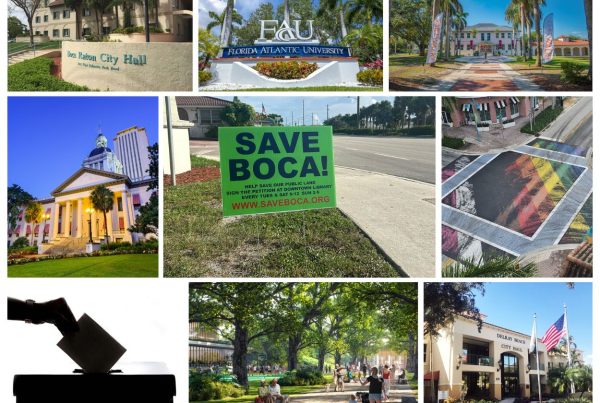Flash flooding
After the financial crisis, many South Florida homes were “underwater” regarding their mortgages. For a while Thursday night, it seemed that many homes in Boca Raton might be “underwater” regarding. . .water.
According to the National Weather Service, nearly six inches of rain drenched the city from late afternoon into early evening. Weather tracking has become so advanced that the Channel 5 meteorologists were able to plot the system’s path across Boca almost neighborhood by neighborhood. Many side streets were flooded. There was water in Town Center Mall and City Hall (above).
Fortunately, problems in most areas didn’t last long. According to a city spokeswoman, however, flooding at Southwest Second Street and Southwest Ninth Avenue closed that area on Friday and Saturday. Ninth Avenue is a popular outlet in the southwest section. Just to the north, there was flooding in Old Floresta.
Despite the downpour that happened in barely three hours, most problems stemmed not from the rain itself but from bad timing and inattention.
Flood control in South Florida is a three-tiered system. The South Florida Water Management District maintains the largest canals. Then come canals of local drainage districts. For southern Palm Beach County, that’s the Lake Worth Drainage District.
At the bottom, and too often overlooked, are neighborhood storm drains that direct water into—and later up—through the system. If those drains get blocked, flash flooding can result.
Many trees, especially oaks, have been dropping leaves. It’s that time of year in South Florida. With those oak leaves comes oak pollen. On Thursday night, storm drains in tree-heavy neighborhoods got clogged. It happened in my southwest neighborhood. Suburban flotsam covered the drain. After I raked it off, water began pouring in.
A similar issue caused the flooding at City Hall. The spokeswoman said leaves had clogged drains on the second-floor flat roof. Water leaked into the second floor, and from there down to the first-floor section where people wait to ask about building permits.
In 1999, Hurricane/Tropical Storm Irene moved up the center of the state. The wet quadrant was on the east, and South Florida got the kind of rain we last saw with Tropical Storm Isaac in 2012. It was the ultimate stress test for municipal stormwater systems.
Boynton Beach’s failed. Flooding was so bad that the city soon after levied a stormwater fee to upgrade the drainage system. The investment has paid off.
For now, the spokeswoman said, Boca administrators don’t believe that Thursday’s rain exposed any systemwide weaknesses. It’s true that such heavy rain in such a short time could tax any system. All neighborhood associations, however, should check that their drains and canals are clear. Water can rise faster than it takes to remember even where the drains are.
Old library, new use
The rain-related disruption at Boca Raton City Hall sped up one change that will affect many of the people who do business with the city.
Because of flooding on the first floor, those who deal with development permits are working in what normally is the waiting area, near the city council chambers. Soon they will move not back to their old space but to new offices in the former downtown library.
For some time, Boca has been reviewing its use of all city facilities. With early voting having moved to the new downtown library, the city considered what to do with the old library across the street from the police station.
Answer: the library will house, among other departments, the permitting staff and the building inspectors. Code Enforcement also will shift. All those employees—about 75 in all—will be on the first floor. The city is adding 20 parking spaces north of the building, bringing the total at the site to about 100. Some administrative offices will take up the second floor.
The plan had been to move the employees next month. Instead, a city spokeswoman said Monday, the move could begin next week. Interior work at the old library is nearly done, and it would make no sense to return employees to space they would be leaving very soon.
The move makes sense. Though the city said recently that the average wait time for a permit has been cut roughly in half over last year, it will be now be easier for contractors and homeowners to meet with city staff. Permit delays had vexed Boca Raton for years. The city has not determined which departments will take over the City Hall space vacated by the permitting staff.
iPic traffic concerns
As I reported, though the Delray Beach City Commission has given final approval to the iPic project, worries about traffic problems linger. Critics fear that the theater/office/retail complex could create a chokepoint on Southeast Fourth and Fifth avenues near Atlantic Avenue.
Though the city, correctly, will monitor traffic, a stronger force may be at work.
During one debate over the project, iPic CEO Hamid Hashemi pointed out that his company’s market is higher-income residents who aren’t used to waiting. If traffic spoils their trip to iPic in Delray, they will go to the company’s theater in Boca or to a competitor. “We can’t let them be upset,” Hashemi said. If he doesn’t upset “them,” the project will be less likely to upset the critics.
Trial dog beach?
In a roughly 100-page report, Delray Beach’s Parks & Recreation Department is recommending a trial program for a dog beach. At a workshop meeting that probably will take place in May, however, City Manager Don Cooper will tell the city commission that he opposes the staff recommendation.
Responding to requests from dog lovers, the commission asked the staff to consider the idea. The recommendation is for a six-month program in an area between 100 yards and 300 yards wide next to Atlantic Dunes Park at Linton Boulevard.
The report notes several favorable factors: the stretch is the widest public beach in Delray, there are two parking meters, there’s a single entrance/exit that would make it easier to monitor compliance and there are bathrooms. People could bring dogs only on Friday, Saturday and Sunday. The fee would be $30 per dog for city residents.
Cooper bases his opposition on four points:
— Many people wouldn’t know that the dog beach had limited hours and was restricted to a certain area. As a result, it could take as many as two police officers and two park rangers to monitor the program. Cooper believes that the report underestimates the number of staff the program would require.
— It would take more time than the report estimates to pick up dog waste from the beach.
— Administrative costs “will put an additional burden on staff.”
— The program would be starting as Delray Beach rebuilds the beach promenade and installs new parking meters. Cooper believes that adding the dog program would “jeopardize the successful outcome of the beach projects,” which are commission priorities.
Though Boca Raton, as the report points out, has a successful dogs-on-the-beach option, Cooper raises good points, especially on timing. Cooper also is probably right when he says in his March 2 letter to the commission that there will be “significant pressure” to approve the program.
It’s also worth nothing that Cooper says he doesn’t want to proceed “at this time.” The dog beach might turn out to be a good idea that just has to wait.








